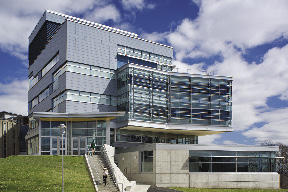According to the architectural design firm Payette, phase one of the 175,000 s/f Carl J. Shapiro Science Center at Brandeis University has been completed. Phase one is 101,045 s/f and phase two is planned for 74,080 s/f. The phase one construction cost is $85 million.
The project team includes construction manager John Moriarty & Associates; MEP engineer Buro Happold; structural engineer Simpson Gumpertz & Heger; civil engineer Nitsch Engineering; and landscape architect Landworks Studio.
The science complex is part of a scaled, phased plan, which reconnects existing buildings and supports multidisciplinary science for top-tier research and teaching. Payette analyzed over 500,000 s/f in 10 buildings at the center of campus to develop the phased renewal and expansion plan. The Shapiro Science Center contains teaching and research spaces for biochemistry, biology, chemistry, and genomics.
"The opening of the Shapiro Science Center is the first step in the university's renewed commitment to scientific education and advancement," said Peter French, executive vice president and chief operating officer of Brandeis University. "Payette's plan creates a blueprint that repairs and rebalances the prominence of Brandeis's science facilities in the fabric of campus life."
Four new landscape precincts help to arrange campus circulation in a river-like organization. A metaphor for pedestrian movement from the upper campus to lower campus, the River organizes lobbies, multi-level spaces and bridges interconnecting new and existing buildings. It also connects cross-campus pedestrian movement through the new science center.
"The new facility is a physical manifestation of the transformational changes that science and technology have prompted in the last generation," said Kevin Sullivan, AIA, principal-in-charge for Payette. "Open staircases throughout the building connect spaces on multiple levels while the upper levels are fully transparent - a symbolic transformation of the once introverted science complex."
The transparent, angular façade of the Shapiro Science Center responds to a steeply sloping site and the predominant Modernist vocabulary of campus. The south facade is a layered, engineered curtainwall with sunshading devices. The other facades are composed of a cementitious fiberboard hung on a rainscreen assembly. Design details highlight the layered thinness of the applied open-joint skin.
Consistent with the university's commitment as a charter signatory to the American College and University Presidents' Climate Commitment, all capital projects at Brandeis are designed and built to a LEED-Silver-equivalent or better standard. Payette's overall approach to sustainability included a holistic renewal of selected buildings rather than wholesale replacement. Building materials include cladding with recycled content, natural linoleum, recycled stone flooring, sustainable solid-surface material, urea-formaldehyde free wood products, low VOC paints, and carpet made with recycled fibers. Interventions include new green roofs, glass bridge connections and bris soleil. Extensive light studies were undertaken to help develop a system of exterior sunshades, which reduce heat loads and support a light harvesting system.
Founded in the 1930s, Payette is a leading architectural design firm specializing in the programming, planning, and design of complex buildings for medical and scientific research, academic teaching, healthcare, and corporate research. Current clients include Massachusetts Institute of Technology, Harvard University, the Pennsylvania State University and Columbia University.
Founded in 1948, Brandeis University is a private research university with a liberal arts focus.
Tags:
Payette completes phase one of 175,000 s/f Shapiro Science Center at Brandeis University
June 17, 2009 - Construction Design & Engineering
 (1).jpg)








.png)